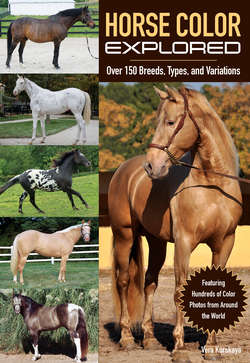Читать книгу Horse Economics - Vera Kurskaya - Страница 33
На сайте Литреса книга снята с продажи.
Bay Dun
ОглавлениеLike the bay base color on its own, the Dun gene in combination with bay (bay dun) has many shades. The horse’s body color can vary from brownish red to almost yellow with light reddish or ochre tinges (Photo 32). The mane and tail and lower legs are black or sometimes dark brown. In dun horses, the tips of black hair frequently lose their color, and therefore the tail and mane can appear “rusty” due to sun exposure. Primitive markings are black or, less frequently, brown-colored. The following distribution and color of markings is most often observed: The mask is dark red or brown, and cobweb markings and any other admixture of dark hair on the body is black. The dorsal stripe and zebra bars can be either of these two colors. The hooves and skin are pigmented, the eyelashes reddish, and the eyes hazel, or sometimes light hazel or yellowish. Some horses show the pangaré trait (sometimes called “mealy”) with lighter hair along the flanks, belly, inner legs, muzzle, and around the eyes (Photo 33 and see p. 72).
It is possible to find bay dun horses with a color that is practically indistinguishable from the usual bay color. Bay dun color is the most common “Wild” color and is often seen in Quarter Horses. It is also frequently encountered in such breeds as Vyatka and Bashkir Horse, as well as other aboriginal horses. The color is rare in some breeds, such as the Andalusian and Lusitano.
